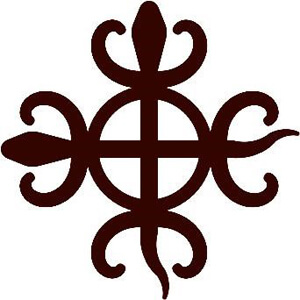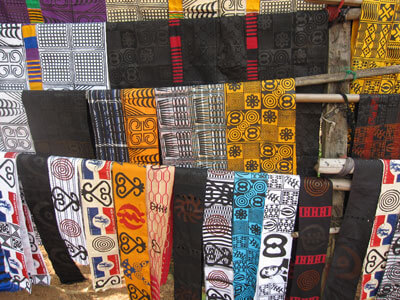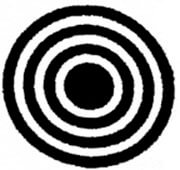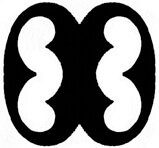Origins
Adinkra are symbols from the West African nation of Ghana. Each symbol holds a meaning that represents important aspects of their knowledge system. In the “twin crocodile” symbol, for example, both animals share a single stomach. This symbol represents the concept that fighting among ourselves for resources is pointless: “By feeding you, I feed myself.”
Cloth stamped with Adinkra symbols can tell a story about which concepts are most important to you. They are worn during special occasions or ceremonies.


Present Day




New innovations have used adinkra to empower communities in many ways. Architects in Ghana have used the shapes in buildings, such as the ram's horn symbol in this balcony. Educators have used them to teach math and computing. An adinkra-like symbol, found in an African American burial ground from 1760, inspired the National Park Service to use adinkra for its memorial in New York City. And in Albany, NY, the adinkra symbol “knot of reconciliation” became the logo for the anti-gun violence group “SNUG,” which buys back guns to keep them off the streets.
Where Did Adinkra Geometric Forms Come From?
Like all cultures, the Ashanti developed their math ideas from both natural and social influences. Below you can see 3 stages:
- Observing an object from nature or culture.
- Artistically representing this object.
- Abstracting the art into geometric forms. This makes the stamps easier to reproduce, and the symbols easier to recognize. And it helps us see why African mathematical traditions were slightly different from those of Europe: there is more emphasis on iteration and logarithmic curves.
From Nature
Original Object

Water Drop
Artistic Representation

Soul Washer"s Badge
Adinkra Symbol

Adinkrahene Symbol
Description
Photos of water ripples are often used to study fluid physics. Ghanaian artisans were also keen observers of fluid shapes. We can identify a ripple pattern in the gold "Soul Washer"s" badge - worn by the Ghana priests who conducted the king"s water rituals. This suggests an origin for the adinkrahene ("king of adinkra") symbol: ripples of power spread in all directions.
Click to Launch SimulationFrom Architecture
Original Object

Temple
Artistic Representation

Temple Door
Adinkra Symbol

"Church" Symbol
Description
Traditional temple layouts in Ghana often use an open courtyard surrounded by roofed verandas. The few that remain today have wood inlays in the doors that appear to show this spirital power spreading like the adinkrahene symbol. The adinkra symbol at far right has been identified today to mean "church," yet it seems likely that it originally referred to the connection of spiritual forces to the traditional temples.
Click to Launch SimulationFrom Animals
Original Object

Bird
Artistic Representation

Artistic Sankofa Symbol
Adinkra Symbol

Abstract Sankofa Symbol
Description
Many shapes created by living organisms can be modeled by using the arc of a log spiral. Some shapes have several full rotations (like a snail shell), while others are just a short arc (like the neck of a bird). Adinkra symbols often use log spiral arcs due to an important feature of biological growth, as we will see in later sections.
Click to Launch SimulationSymbols & Meanings
Each symbol has a name in Twi, the language of the Ashanti people. This name translates to a literal meaning and a symbolic meaning. Below are some adinkra and their corresponding information, such as their symbolic meaning and the proverbs on which they are based.

Twi Name:
Gye Nyame ("jeh N-yah-mee")
Literal Translation:
"Except for God"
Symbolic Meaning:
Supremacy of God
Proverb:
Only God has the power of life.

Twi Name:
Akoko Nan ("ah-ko-ko non")
Literal Translation:
"The Leg of a Hen"
Symbolic Meaning:
Mercy, Nurturing
Proverb:
The hen treads upon its chicks, but it does not intend to kill them.

Twi Name:
Sankofa ("sang-ko-fah")
Literal Translation:
"Return and Get It"
Symbolic Meaning:
Learn from the Past
Proverb:
It is not taboo to return to fetch something you forgot earlier on.

Twi Name:
Dwennimmen ("djwin-knee-mann")
Literal Translation:
"Ram"s Horns"
Symbolic Meaning:
Humility and Strength
Proverb:
It is the heart and not the horns that leads a ram to bully.

Twi Name:
Adinkrahene ("a-dink-kra-hen-knee")
Literal Translation:
"Chief of the Adinkra Symbols"
Symbolic Meaning:
Greatness, leadership
Proverb:
This symbol is said to have inspired the creation of the other symbols. "Hene" is the Twi word for "king" or "leader."

Twi Name:
Pempamsie ("pim-pam-see-ah")
Literal Translation:
"Sew in readiness"
Symbolic Meaning:
Steadfast; prepared
Proverb:
The links of a chain symbolize both the strength of unity and importance of preparation.